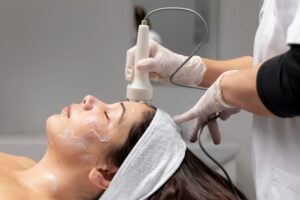When it comes to reducing fine lines, wrinkles, and signs of aging, many individuals face the dilemma of choosing between Fibroblast Plasma vs. Botox. Both treatments are popular, effective, and have helped countless people achieve more youthful appearances. However, each works differently, and choosing the right one depends on your specific skin concerns, goals, and lifestyle. In this guide, we’ll break down the differences between Fibroblast Plasma and Botox, so you can make an informed decision about which treatment is best for you.
Understanding Fibroblast Plasma
Fibroblast Plasma therapy, also known as plasma pen treatment, is a non-invasive procedure that uses plasma energy to create micro-injuries on the skin’s surface. This stimulates collagen and elastin production, which helps tighten and rejuvenate the skin. Unlike surgical options, this procedure doesn’t require cuts or incisions, and the recovery time is minimal.
Fibroblast Plasma is particularly effective in treating:
- Fine lines and wrinkles
- Loose, sagging skin
- Crow’s feet, smile lines, and neck tightening
- Scars and stretch marks
Because it works by promoting the body’s natural collagen production, the results are long-lasting and improve over time, making it an appealing option for those looking for gradual, yet noticeable improvements.
Understanding Botox
Botox, short for botulinum toxin, is an injectable treatment that temporarily relaxes facial muscles to reduce the appearance of dynamic wrinkles—those that form due to repetitive facial movements, like frowning or smiling. Botox is commonly used to treat:
- Forehead lines
- Crow’s feet around the eyes
- Frown lines between the eyebrows
Botox provides quick results, usually within a few days, but its effects are temporary, lasting about 3-4 months. Regular treatments are necessary to maintain the smooth appearance, which makes it a convenient option for those looking for fast and short-term improvements.
Fibroblast Plasma vs. Botox: Key Differences
- How They Work
Fibroblast Plasma uses plasma energy to target and stimulate fibroblast cells, encouraging natural skin rejuvenation over time. In contrast, Botox temporarily relaxes the muscles responsible for dynamic wrinkles, offering immediate wrinkle reduction without stimulating natural skin repair. - Longevity of Results
Fibroblast Plasma results are long-lasting, with improvements continuing over several months due to collagen production. Most patients in San Jose enjoy their results for up to two years. On the other hand, Botox needs to be repeated every 3-4 months to maintain its wrinkle-reducing effects. - Treatment Areas
Both treatments are versatile, but Botox is generally better suited for dynamic wrinkles (like those on the forehead and around the eyes), while Fibroblast Plasma excels at tightening skin and treating static wrinkles or sagging. - Invasiveness
Neither Fibroblast Plasma nor Botox involves surgery, but they differ in how invasive they feel. Botox is minimally invasive, with small injections, while Fibroblast Plasma involves the use of a plasma pen to create controlled micro-damage on the skin’s surface. - Cost
The cost of these treatments can vary. Botox tends to have a lower upfront cost but requires maintenance every few months. Fibroblast Plasma may cost more initially, but since the results last longer, the overall cost can be more manageable over time. Prices in San Jose will vary depending on the clinic and specific treatment areas.
Which Treatment is Right for You?
Choosing between Fibroblast Plasma vs. Botox depends on your unique needs and preferences. If you’re looking for a quick fix for dynamic wrinkles and are comfortable with regular maintenance, Botox might be the better option. However, if you’re seeking longer-lasting results and are focused on overall skin tightening and collagen production, Fibroblast Plasma could be the ideal solution.
For San Jose residents, environmental factors like sun exposure and dry climate can accelerate the appearance of wrinkles and sagging skin. Fibroblast Plasma’s ability to naturally stimulate collagen may offer more comprehensive, long-term benefits for addressing these issues.
Conclusion: Find the Right Treatment for You
Both Fibroblast Plasma and Botox offer excellent benefits, but the right choice depends on your skin goals, budget, and the results you’re after. If you’re unsure which treatment is best for you, consider booking a consultation with a qualified specialist who can help guide your decision. At our San Jose clinic, we specialize in offering both Fibroblast Plasma and Botox treatments, ensuring you receive personalized care for your skin’s needs.
Ready to take the next step toward youthful, glowing skin? Contact us today to schedule your consultation and learn whether Fibroblast Plasma or Botox is right for you!
FAQs
What are the main differences between Fibroblast Plasma vs. Botox?
Fibroblast Plasma uses plasma energy to promote collagen production and skin tightening, while Botox temporarily relaxes muscles to reduce wrinkles. Fibroblast Plasma results last longer (up to two years), whereas Botox requires regular maintenance every 3-4 months.
How long do the results of Botox last compared to Fibroblast Plasma?
Botox results last around 3-4 months and require frequent touch-ups, while Fibroblast Plasma results improve over time, with effects lasting up to two years.
Can I combine Fibroblast Plasma with Botox for better results?
Yes, combining Fibroblast Plasma with Botox is possible for a more comprehensive approach to skin rejuvenation. Botox can target dynamic wrinkles, while Fibroblast Plasma addresses skin tightening and collagen production. Always consult with a specialist to determine the best combination for you.
Which treatment has a faster recovery time: Fibroblast Plasma or Botox?
Botox has a faster recovery time, with most patients experiencing only minor swelling or bruising at the injection site. Fibroblast Plasma, while non-invasive, requires a longer recovery time of about 5-10 days due to the formation of small scabs as the skin heals.
Is Fibroblast Plasma or Botox more suitable for treating sagging skin?
Fibroblast Plasma is more effective for treating sagging skin as it promotes collagen production and skin tightening. Botox is better suited for reducing the appearance of wrinkles caused by muscle movement, such as forehead lines and crow’s feet.






